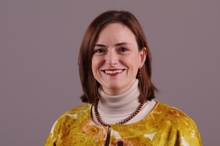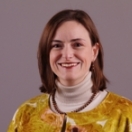

Christine Reich is being recognized as a Champion of Change for leading education and employment efforts in science, technology, engineering and math for Americans with disabilities.
“One of the most pervasive messages of my childhood was, ‘Not for you.’ That’s something that’s incredibly destructive for the life of a child. Places like science museums can dispel those messages more than almost any place else. I remember my few visits to museums as just wonderful. I believe everybody should have that experience. And I do mean everybody.”
- Betty Davidson, retired Museum of Science exhibit developer, biochemist, wheelchair user, and personal mentor
People with disabilities frequently receive the message that science learning is “not for you.” Sometimes this message is subtle, sent through the design of science learning experiences that do not take into account the physical, sensory, and cognitive diversity that exists within our society. Other times, the message is overtly stated, rooted in narrow perceptions of what a person with a disability can and cannot do. It is time for the message to change. It is time for us to take actions that send the message that learning about and engaging in science, technology, engineering, and mathematics (STEM) is possible for all.
Science museums can play a pivotal role in changing that message. When designed to be inclusive, the self-directed and social learning experiences science museums offer can lead people with disabilities to feel competent and empowered as science learners and generate excitement and enthusiasm for science. When the inclusion of people with disabilities is not taken into account, those same people can feel disempowered, frustrated, uncomfortable, and alienated from science. It is our awareness of the positive effects of inclusion and the negative effects of exclusion that drives me and my colleagues at the Museum of Science, Boston to continually seek new and better ways to include people with disabilities in informal science learning. We want everyone to feel that learning about STEM is “for me.”
At the Museum of Science, we’ve embraced a universal design philosophy when developing our educational programs and exhibits. Such a philosophy pushes us to extend beyond the basic requirements of the ADA to fully address the spirit of the Act. We strive to create environments where people with disabilities can engage in meaningful science learning activities alongside their friends and family. This approach has led us to create rich learning environments where content is delivered in multiple formats (through text, audio, images, and sometimes even virtual American Sign Language tours), and educational activities engage all of the senses. Our galleries offer visitors not only artifacts to look at, but also objects to touch, sounds to hear, and things to smell. An early study conducted at the Museum of Science found that such an approach significantly enhanced the educational experience of people with and without disabilities, extending the amount of time Museum visitors spent in one of our natural history exhibitions and dramatically increasing the percent of visitors that understood the exhibition’s educational content. Furthermore, more recent evaluations found that this approach creates exhibitions where people with and without disabilities come away understanding similar science-related messages and practicing similar science thinking skills.
The Museum of Science, however, cannot change the message on its own. Knowing that collective change across an entire field is much more powerful than change within any one institution, the Museum is now taking action to advance the inclusion of people with disabilities within the science museum field as a whole. With funding from the Institute for Museum and Library Services, we are studying the organizational conditions that foster and impede the inclusion of people with disabilities in science museums across the nation.
Knowledge from this research study informs the actions we take for change. For example, the study elevated our awareness of how the lack of materials and resources available within the field for the design of inclusive digital interactives hinders many museums from engaging people with disabilities in science learning. Based on this finding, we sought funding from the National Science Foundation to address this challenge, and with this funding, we will be hosting a design charrette at the end of May to generate new designs and resources any science museum can employ to develop digital interactives that are inclusive of people with disabilities. This charrette brings together people with and without disabilities who are museum exhibit designers, accessible technology experts, and science education specialists, who will all be working collaboratively to effect change through innovation.
In a time where science and technology play an expanding role in our daily lives, it’s imperative that we change the message American society sends to people with disabilities about engagement in science, technology, engineering, and mathematics. Science museums can play a pivotal role in changing the message so that everyone, including people with disabilities, feels that science learning is “for me”.
Christine Reich is Director of Research and Evaluation at the Museum of Science, Boston, one of the world's largest science centers. The Museum of Science brings science, technology, engineering, and math to about 1.5 million visitors a year through its dynamic programs and interactive exhibits.


